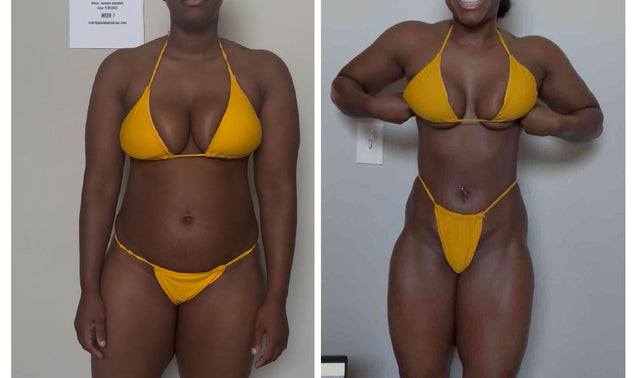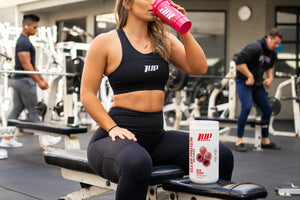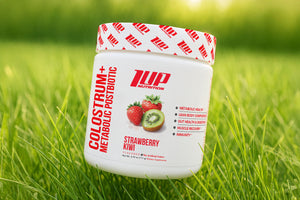We all want to see results from our time spent in the gym each week.
And part of seeing results from training is making sure that you are actually training hard.
To get “in the zone” and improve training intensity, many gym-goers simply mix up a serving of pre-workout 30 minutes before hitting the gym (or drink it as they’re walking into the gym), and get to work.
And, while this is a “good” way to improve your workout, it doesn’t take into account the “bigger” picture of what’s really needed to get the most from your training program.
Yes, if you want to burn fat and build muscle, you need to work out hard, but in the grand scheme of things, your workout is only 60-90 minutes of your day. That leaves a tremendous amount of time available to incorporate other means of improving your workout and enhancing your results.
Here are 10 habits you should try incorporating into your fitness routine if you want to improve your workout and maximize your results.
Top 10 Ways to Improve Your Workout
Get Enough Sleep
We’ve said it before, and we’ll continue to say it again and again and again.
If you want to be the very best you (including how you look and perform in the gym), you must get enough sleep each night.
Unfortunately, sleep is an afterthought for most people for whatever reason. Typically, it’s something along the lines of “I’ll sleep when I’m dead” or “Sleep is for old people and babies.”
The reality is, if you aren’t getting enough sleep, you’re severely limiting your performance in the gym.
Sleep deprivation reduces cognitive function, motivation, strength, and stamina. Furthermore, not getting enough sleep also hinders recovery from exercise.
Add it all together and a lack of sleep leads to a lack of results.
By getting enough sleep, you’re replenishing energy stores, prime your muscles and mind to perform optimally, and stoke your metabolism for maximum calorie burning.
If you need help getting a quality night’s sleep, click here.
Do a Proper Warm-Up
All too often people jump right into their working sets, neglecting to properly warm up. While this might seem like a time-saving maneuver, it’s also limiting how well you perform in your workouts.
This is why we’re fans of always warming up prior to training.
The warm-up serves three primary functions:
- It increases synovial fluid in the joints, which reduces friction, lubricates joints, and lowers the risk of joint or cartilage injury during training.
- It raises core temperature and blood flow to the working muscles
- It enhances neuromuscular coordination and stabilization
Now, many individuals think properly warming up is spending 15-20 minutes on the treadmill or bike. And while that’s better than no warm up at all, it’s far from the optimal way to prime the body for resistance-training workouts.
If you’ve been sitting around all day, going for a short 5-10 minutes walk or jog can help increase circulation, but you also want to perform movements that mimic the movements you’ll actually be doing during your workout.
So, for instance, if you are performing an upper body workout, you’ll want to perform some dynamic movements that increase blood flow and lubricate the joints of the upper body.
Examples of upper body warm up movements include:
- Shoulder dislocations
- Band pull-aparts
- Push ups
- Face pulls
- Light weight presses
- Light pulldowns
Essentially, you want to execute movements that mirror those in your workout.
Spending too much time jogging, spinning, or foam rolling (>15 minutes) is just wasting time and energy.
Do a brief dynamic warm up (5 minutes or so), and then get to your “priming” or “ramping up” sets. This helps get your body ready for the more intense work ahead as well as get you focused on what the goal of your workout is.
Check Your Pre-Workout Nutrition
As much time as people devote to finding the best pre workout or best training program, they would be better served by looking at how they are fueling their bodies in the hours leading up to their workout.
Proper nutrition is crucial to being able to perform to your best during an intense workout, and avoid “hitting the wall” or “bonking” as a result of low glycogen stores (glucose stored in the muscles to be used for energy during exercise).
When blood sugar and glycogen levels are low, your body will start breaking down muscle and fat as it needs some sort of energy to continue training.
Having a carbohydrate-rich meal 1-2 hours before training can help top off glycogen stores for your workout and ensure you have stable blood sugar levels during training, which fosters better focus and performance -- helping you burn more calories and get better results.
Hydrate!
The human body is comprised of ~60% water, and water also plays an important role in just about every biological process that takes place in our bodies.
As such, being sufficiently hydrated is paramount if you want to avoid fatigue and perform to the best of your abilities.
Research has shown that even as little as 2% dehydration can reduce stamina, increase fatigue, decrease focus, and heighten the risk of cramps and injury.[1]
How much water you drink depends on a number of factors, including height, weight, training environment, and how long you will be working out. So, there’s not a one-size-fit-all answer.
But, a good practice is to drink 16-20 ounces of water in the hour or two leading into your workout. An easy way to get this water in is to mix your serving of pre workout into water and drink it.
Review Your Workout
Preparation is key to success.
This not only applies to your nutrition plan (i.e. meal prep), but also to your exercise program.
Having a plan of attack can help make the difference between an effective training session that brings you closer to your goals or a “workout.”
Many individuals fail to see results from their training program because they don’t have a plan of attack. They merely walk into the gym and do whatever the feel like.
While this approach is OK every now and then.
If you really want to gain strength, build muscle, and/or lose fat, you must have a plan.
Having a workout plan tells you what exercises to do, what order to do them, and how many sets and reps you should perform in your workout. They also tell you how long to rest between sets.
Basically, a workout plan is your roadmap to success in the gym. It eliminates the guesswork and can help make your time spent in the gym each day more effective.
Due to the importance a workout program can have in your transformation challenge, we provide a customized training program to each contestant who enters.
Great Music Playlist
It’s a primal instinct. When we hear great music, we move.
Whether it be on the dance floor, in the shower, or at the gym, music drives movement.
It helps boost levels of feel good hormones/neurotransmitters like dopamine and serotonin, and it just so happens that listening to a great soundtrack during your workout can improve your performance.
More specifically, a 2012 review of the literature found that music helps exercisers push themselves for a longer period of time during their workouts, which helps increase calorie burning.[2]
Researchers also noted that listening to music during training helps lower levels of perceived exertion (how “hard” you feel the exercise is) and maintain a better overall mood while exercising.
Essentially, having a great playlist puts you into a “flow state” where you are able to push harder for longer, while feeling better during your workout!
No Texting, Watching YouTube or Scrolling Through Instagram or Facebook
As great as modern technology seems, it’s not without its faults.
One need only look around restaurants and coffee shops to see first hand that people are too locked into their phones.
Rather than engage in an evening of conversation, enjoyment, and fellowship, the modern diner would rather scroll through their social media feed, take selfies, or text people.
This phone-addicted lifestyle has extended into gym life as well.
Instead of preparing for the next set of an exercise, or pushing hard during cardio, individuals are texting, snapping, scrolling, and watching on their phones.
If you want to improve your workout and finally start taking your workouts seriously this year, the biggest change you can make is to STOP using your phone at the gym.
No watching YouTube.
No scrolling through insta-face.
No texting, tweeting, or snapping.
You’re at the gym to put in the work, not give off the impression that “you lift.”
Time Your Rest periods
Building off the previous point, many people are in the gym for significantly longer than they need to be due to spending too much time on their phones and not timing their rest periods.
They do a half-hearted set than immediately jump on their phone.
Next thing you know, 15 minutes have gone by and they finally start their next set.
While this amount of rest might be necessary for a world-class powerlifter, this amount of rest is absolute overkill for the average individual looking to drop a few pounds of fat, build muscle, or improve fitness.
Timing your rest periods helps keep intensity high during your workout (which helps increase calorie burn) and also helps ensure you’re focused on what’s up next in your workout, not dawdling away the minutes on social media.
Most gyms have a clock on the wall that you can use to time your rest periods.
If they don’t, you can use your watch or smartphone (provided it’s set to airplane mode).
Keep a Training Journal
Earlier we discussed how important it was to follow a workout program when you hit the gym as it serves as your roadmap to success.
But, having a workout plan is only part of what’s needed to ensure success when you hit the gym.
The workout plan tells you what to do each time you hit the gym.
However, in order to make sure you’re actually progressing in your workouts, you need to write down what you are doing in your workouts in your training journal.
Training journals provide a place for you to record how you did in your workout.
- What exercises you performed.
- How many sets and reps you completed.
- How long you rest between sets.
- How you felt during the workout.
By writing down this information and keeping track of it over the days and weeks to come, you will see what you have previously done, so you know what you need to do in the following workout.
Supplement Intelligently
As we mentioned at the very beginning of this article, the cornerstone of many gym-goers exercise ritual is to drink a serving of pre-workout before hitting the gym.
But, not all pre workouts are created equal.
Many pre workout supplements on the market are nothing more than a glorified cocktail of stimulants.
To make matters worse, many of the same supplements also use proprietary blends, which means you have no idea how much of each stimulant you are consuming.
These products are largely ineffective and also pose a serious hazard to supplement consumers.
1UP Nutrition offers both a men’s and women’s pre workout supplement that are transparently dosed, which means you know exactly what you are putting into your body as well as how much you are putting in.
1UP pre workouts also contain quality doses of research-backed ingredients, including Citrulline, Beta Alanine, Betaine, and Agmatine. We’ve also included powerful focus-boosting agents such as Huperzine and Tyrosine to help keep you “in the zone” all workout long.
Aside from a quality pre workout supplement, you may also want to consider an amino acid supplement and/or a carbohydrate supplement as these help keep energy levels high, reduce the onset of fatigue, and combat muscle breakdown.
Takeaway
You don’t need any gimmicks, fads, or “hacks” to improve your workout.
These 10 tips can be used by anyone -- beginner, intermediate, or advanced.
When combined with a proper nutrition plan (including your post workout shake), these tips can help you start seeing better results faster from your workouts.
Start implementing these 10 tips right NOW and be on your way to the ultimate body transformation!
References
- Barr, S. I. (1999). Effects of dehydration on exercise performance. Canadian Journal of Applied Physiology = Revue Canadienne de Physiologie Appliquee, 24(2), 164–172.
- Costas I. Karageorghis & David-Lee Priest (2012) Music in the exercise domain: a review and synthesis (Part I), International Review of Sport and Exercise Psychology, 5:1, 44-66, DOI: 10.1080/1750984X.2011.631026






